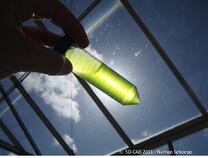 If Dr. Seuss were still writing his wonderous books and turned his attention to biotechnology today, we might see a title like Ah, the Things You Can Do With Algae! At the University of California San Diego a number of research institutions have joined together to form the San Diego Center for Algae Biotechnology (SD-CAB) where scientists are pursuing all sorts of innovative projects using the ubiquitous green matter that also happens to be a genetic model organism. Which means it is not only easy to grow, but it can do things that bacteria and even mammalian cells can't, like host a genetically engineered protein that targets cancer.
If Dr. Seuss were still writing his wonderous books and turned his attention to biotechnology today, we might see a title like Ah, the Things You Can Do With Algae! At the University of California San Diego a number of research institutions have joined together to form the San Diego Center for Algae Biotechnology (SD-CAB) where scientists are pursuing all sorts of innovative projects using the ubiquitous green matter that also happens to be a genetic model organism. Which means it is not only easy to grow, but it can do things that bacteria and even mammalian cells can't, like host a genetically engineered protein that targets cancer.
[Image courtesy of SD-CAB, by Nathan Schoepp]
Dr. Stephen Mayfield is a UCSD biologist and director of SD-CAB. It is his lab team's research into therepeutic protein uses of algae that has been in the news, most recently for an algae-based cancer drug that functioned like an expensive and complicated designer drug but was much cheaper and simpler to produce. The paper was published in PNAS, and since then Dr. Mayfield was interviewed about his research for a public television program (below). While the UCSD press release quotes Mayfield as saying “Because we can make the exact same drug in algae, we have the opportunity to drive down the price down dramatically,” he is more circumspect in the video, saying that they will focus on developing drugs that do things current drugs can't.
[Dr. Mayfield discusses his research breakthrough with KPBS host Peggy Pico]
A fusion protein is a drug made up of two parts: the first is an antibody which zeros in on a cancer cell; the second is a toxin that kills that cell after the antibody has bonded to it. The difficulty in creating this type of therapeutic compound is keeping the toxin from killing the antibody it rides in on, on the one hand, and working with an organism that is sufficiently complex to allow for the 3-D protein folding required to build the antibody that targets the cancer. Algae satisfies both these requirements, and it does so because of its chloroplasts: specialized subunits within the algal cell that carry out photosynthesis. Mayfield describes the experiment:
“The protein was sequestered inside the chloroplast...And the chloroplast has different proteins from the rest of the cell, and these are not affected by the toxin. If the protein we made were to leak out of the chloroplast, it would have killed the cell. So it’s amazing to think that not one molecule leaked out of the chloroplasts. There are literally thousands of copies of that protein inside the chloroplasts and not one of them leaked out.”
Working in conjunction with UCSD School of Medicine's Dr. Joseph Vinetz, a specialist in tropical diseases, Mayfield earlier this year turned his algae research towards the vexing global problem of producing a cheap, effective malaria vaccine. The progress on that very promising project was pubished in PLoS One and reported in a UCSD news release in May. Indeed, Mayfield sees no reason why algae couldn't be used for any number of fusion protein therapeutics. The cancer drug they developed was just a start, and more of a test than a precursor to a clinical trial, which Mayfield says will not be pursued for that particular drug. What he would like to do next is to target an aggressive, terminal cancer that both humans and canines get in a similar form, and develop a drug that can be tested by treating dogs in a veterinary setting.
The Center for Algae Biotechnology grows and studies algae for many of its properties and potentialities. We've been hearing a lot about algae as a biofuel candidate, and the promise of a green fuel is a strong motivator for understanding and engineering this fast-growing organism. What Dr. Mayfield and his colleagues are showing us is that there's even more to the once maligned pond scum than we ever imagined. Its therapeutic biotechnologies may soon even eclipse its biofuel fame, since the problem of scale makes issues such as water usage relatively insignificant for drug development. San Diego is an ideal center for this field of research as well because it is a marine environment (the Scripps Institute is one of SD-CAB's collaborators) but also has access to the farmlands of the central valley for growing more of the green miracle.
 [SD-CAB Algae drying tank, courtesy of the Center for Algae Biotechnology]
[SD-CAB Algae drying tank, courtesy of the Center for Algae Biotechnology]
Biotechnology Calendar, Inc. was founded 20 years ago to bring scientific events and new technologies to life science researchers at UCSD. Now a nationwide science tradeshow and marketing company, we still hold our popular flagship San Diego Biotechnology Vendor Showcase™ event twice annually on the UCSD campus, with investigators attending from across the life science community, including affiliate institutions like Scripps Research and the Salk Institute.
Our next Biotechnology Vendor Showcase™ Expo will take place February 14, 2013. For information on exhibiting and to receive a free UCSD funding report, click the button below:


